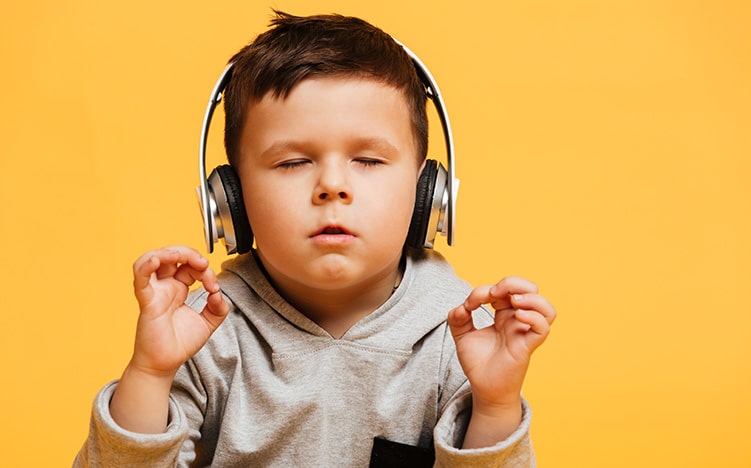Mindfulness for Children
Category: Meditation for Students and Families

If you’re a parent or children’s caregiver, you well know that caring for small children can be challenging. Moments of intense joy, closeness and wonder might be peppered with bewilderment and concern if the child seems unhappy or misbehaves. And even if your own children are perfect angels, you surely know other bambinos who are really a handful. You wonder what you can do to help your darlings remain contented and balanced as they navigate the choppy waves of childhood.
Mindfulness for kids is an effective technique that helps children develop a deeper sense of self-awareness, better control of their emotions and improved concentration. Some of the exercises are simple enough for any child to perform. In mindful listening, for instance, children are guided through a brief meditation session during which they pay attention to different sounds. A regular practice of mindful listening helps children settle and relax before they have to work on homework or other tasks and chores.
Does meditation for children really help?
Many of today’s kids spend most of their free time on electronic devices cyber-conversing on social media, playing video games or the like. Many experts believe that when these distractions replace true interpersonal connections and more creative and tactile pastimes, feelings of discontent, alienation, and disconnection can result. Indeed, the World Health Organization has recently added “gaming disorder” to the list of addictive mental health conditions.
Even kids who aren’t wed to their devices can find it difficult to balance their school life, family life, social life and personal time. They’re subject to the same feelings of stress and fatigue that adults are. If not checked, the buildup of tensions can culminate in a stream of negative emotions.
Studies that explore the impact of mindfulness meditation on kids’ scholastic achievements suggest that the practice leads to increased focus, better concentration and improved memory. Mindfulness helps children remain grounded and savor the present moment. It’s also been shown to help them connect with their natural empathy and better understand their feelings so they can manage them more effectively. This enhances kids’ sense of self-worth and gives them more space to express their innate creativity and compassion.
In truth, mindfulness is one of the best gifts we can offer children. It’s an important tool that will continue to be extremely beneficial as they continue to grow. Many grown-up meditators wish they’d begun practicing earlier, when their minds and bodies were more flexible!
Three good mindfulness techniques for kids
Mindful Breathing
Mindful breathing is much the same for kids as for adults. Kids are usually introduced to the technique by a teacher or adult who already practices meditation. Kids usually begin with a bit of guided meditation to help them relax and focus, then they spend a few minutes of awareness of the breath, and finish up with a minute or two of “checking in” – how do they feel? What, if anything, have they discovered during this session? Do they have any questions about the practice itself?
This mindful progression – guided meditation, quiet awareness and checking in – is the same whether the practice focuses on the process of breathing, seeing or listening. Note that there are no right or wrong responses during the last phase of the practice – this isn’t a test! Kids, parents and caregivers are learning that they can acknowledge their experiences without feeling that they need to react one way or another.
Mindful Seeing
Mindful seeing techniques use the sense of sight to help children learn a different kind of focusing. A small object is usually placed in front of the kids before the session begins. It can be a pebble, a flower, a keepsake, or any other visual anchor. This serves as the focal point of the mindful meditation. It’s important for the kids to understand that the chosen object is an anchor for the mind to settle in on so it can relax and be present. It’s not something that needs to be analyzed or discussed, and it’s not homework!
Mindful Listening
Mindful listening, like the two others, is about maintaining non-judgmental awareness. In this case the focal point is sound. Here again, the progression is guided meditation, quiet listening and checking in. What did they hear? Their heartbeats, birdsong, traffic, a lawnmower, the sound of swallowing, a phone ringing or a text message pinging? Can they be aware of these sounds without having to act on them? What does that feel like?
How to introduce mindfulness to your children:
- Be good role models. Parents and caregivers should set the example if they’re truly interested in teaching children about mindfulness. When kids see you meditating, their curiosity increases and they naturally want to follow your example and try it themselves.
- Make it simple and engaging. You don’t want to complicate mindfulness for kids. Try using techniques that will naturally capture their attention – here again mindful listening is a great method. You can also use imagery and stories to talk about meditation.
- Encourage communication and feedback. Just like adults, kids are likely to become more aware of their feelings when they meditate. Invite your kids to share what they’ve discovered; use this awareness for open, respectful and accepting communication.
- Make it fun: kids love having fun – who doesn’t? Make mindfulness exercises something to look forward to by changing focus from time to time. Bring books and tales to share. Find a special place in your house that can be the kids’ special meditation corner. Encourage your kids to come with their own trinkets and trophies and help you set it up. Create a “meditation cape” or “meditation blanket” together that they can wear during mindfulness sessions – you might even make another one that you can use! Think about what would have made mindfulness meditation special for you if you had begun earlier, and give your children the incomparable gift of awareness.
All of these are great ways of teaching meditation to children. There are numerous resources to accompany you and your child on your mindful journey.






